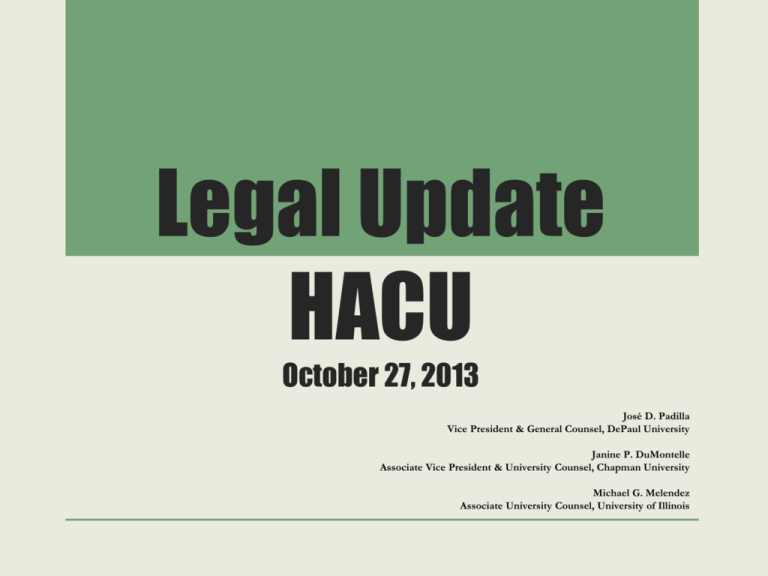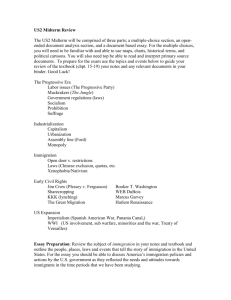
Legal Update
HACU
October 27, 2013
José D. Padilla
Vice President & General Counsel, DePaul University
Janine P. DuMontelle
Associate Vice President & University Counsel, Chapman University
Michael G. Melendez
Associate University Counsel, University of Illinois
• Status of Affirmative Action, Jose Padilla
• Title IX Regulations, Janine DuMontelle
• Undocumented Students, Michael Melendez
Status of Affirmative Action
José D. Padilla
Vice President & General Counsel
DePaul University
jpadill7@depaul.edu
Fisher v. University of Texas
Abigail Fisher
• White Female
• Denied admission
• Wasn’t eligible for 10% rule
• Wasn’t admitted under Supplemental Plan
Status of Affirmative Action
Fisher v. University of Texas
Supplemental Plan –
Race & Ethnicity are Buried Deep
• Two numerical indices:
• Academic Index
• Personal Achievement Index
• Personal Achievement Index
• Three Components, including Personal Achievement Score
Status of Affirmative Action
Fisher v. University of Texas
Personal Achievement Index
• Personal Achievement Score
• Six sub-factors
• Last one: Special Circumstances
• Special Circumstances
• Seven possible elements
• Race & Ethnicity
Status of Affirmative Action
Fisher v. University of Texas
Supplemental Plan Criteria
Academic Index
Personal Achievement
Index
Two Essays
Personal
Achievement Score
Six Factors – include
Special Circumstances
Seven Elements - include
Race & Ethnicity
Status of Affirmative Action
Fisher v. University of Texas
The Issue Before the Supreme Court
• Did Texas’ consideration of race violate the Equal Protection
Clause of the 14th Amendment?
• More practically, would the court uphold its 2003 decision in
Grutter vs. University of Michigan?
Status of Affirmative Action
Fisher v. University of Texas
Grutter vs. University of Michigan
• Public universities have a compelling interest in achieving a
diverse student body and the educational benefits that flow from
that diversity.
• Therefore universities could consider race in admissions, but in a
limited way.
Status of Affirmative Action
Fisher v. University of Texas
Grutter & Strict Scrutiny
• But use of race had to meet the constitutional standard of ―strict
scrutiny‖:
• Was it narrowly tailored to achieve the university’s
compelling interest in attaining a diverse student body?
• In Grutter vs. University of Michigan, it was narrowly
tailored because race was of one of multiple ―plus‖ factors
that were considered in admissions.
Status of Affirmative Action
Fisher v. University of Texas
Fisher’s Holding
• In 7-1 decision, Fisher Court didn’t change basic principles in
Grutter.
•
Attaining student diversity still a compelling governmental
interest.
•
Still defer to university’s judgment that a diverse student
body is necessary to meet its educational goals.
Status of Affirmative Action
Fisher v. University of Texas
Fisher & Strict Scrutiny
• But no deference to whether use of race meets strict scrutiny,
i.e., whether its use is narrowly tailored.
• To use race, university has burden of proving that race-neutral
alternatives wouldn’t generate student body diversity.
• Court must verify this narrow tailoring through careful
examination.
Status of Affirmative Action
Fisher v. University of Texas
Fisher on Remand
• Court didn’t decide the merits. Remanded to the Fifth Circuit
Court of Appeals to apply strict scrutiny to the facts here.
• Fifth Circuit has asked parties to address these questions in
briefing.
• Oral arguments on November 13th.
Status of Affirmative Action
Overview of Title IX
Janine P. DuMontelle
Associate Vice President & University Counsel
Chapman University
jpdumont@chapman.edu
History of Title IX
• Part of the Higher Educational Amendments of 1972.
• Amends the Higher Education Act of 1965.
• Early focus was on employment practices of federally financed
institutions.
Title IX Overview
Focus on Sports
• When final enforcement details published in 1975 in the Federal
Register this drew attention to the impact on athletics.
• Towers Amendment – sought to exempt revenue generation
sports.
• Javits Amendment prevailed – sports included ―reasonable
provisions considering the nature of the sport‖.
• 1979 further clarifications in the Intercollegiate Athletics Policy
Interpretation.
• 1980 HEW split and oversight for Title IX was given to the
Department of Education’s Office of Civil Rights OCR.
• 1994 Equity in Athletics Disclosure Act – required disclosure
information on athletic rosters.
Title IX Overview
More than Sports
• While Early focus was on athletics, Title IX of the Education
Amendments of 1972 prohibits discrimination based on sex in
education programs and activities that receive federal
financial assistance.
• Examples of the types of discrimination that are covered under Title
IX include:
• sexual harassment.
• the failure to provide equal opportunity in athletics.
• discrimination in a school’s science, technology, engineering,
and math (STEM) courses and programs.
• discrimination based on pregnancy.
• Title IX prohibits retaliation for filing an OCR complaint or for
advocating for a right protected by Title IX. Title IX also prohibits
employment discrimination, but employment discrimination
complaints filed with OCR are generally referred to the Equal
Employment Opportunity Commission.
Title IX Overview
Recent OCR Guidance
•
Refocus on sexual harassment and sexual violence.
•
It has always been about equity and fairness.
•
Not really new
•
January 19, 2001 OCR Policy Guidance
• Stop harassment when it occurs and prevent reoccurrence
•
January 25, 2006 DCL
• Reminded recipients of standards applicable to sexual harassment
•
October 26, 2010 DCL
• Bullying and Hazing
•
April 4, 2011 DCL
• Provides guidance and examples about Title IX requirements and
how they relate to sexual harassment and sexual violence
• Lays out proactive steps institutions can take to prevent sexual
violence and educate the university community
• Provides examples of the types of remedies schools and OCR may
use to respond to sexual violence
Title IX Overview
Actions Following 2011 DCL
• Trained Title IX Coordinators.
• Reviewed and Revised of Grievance Procedures
• Notice of Procedures – widely distributed
• Ensure Grievance Procedures Applies to Complaints against
Students, Employees and Third Parties
• Ensure Process is Adequate, Reliable, Impartial and Uses
Preponderance of the Evidence Standard
• Designated and Reasonably Prompt Timeframes
• Notice of Outcomes
• Prevention and Remediation
Title IX Overview
Actions Following 2011 DCL, continued
• Confidentiality
• Even if the complainant asks that no steps be taken
institution must take all reasonable steps to investigate and
respond to the complaint.
• If complainant insists that his or her name not be used or
other identifiable information disclosed the institution
should inform the complainant that its ability to respond
may be limited.
Title IX Overview
Goals after you Receive a
Title IX Complaint
• End the Harassment and Prevent Further Harassment
•
•
•
•
•
Minimize burden on complainant
No contact orders
Reassignment of housing
Interim suspension of accused
Discipline the harasser
• Remedy the Effects of Misconduct
• Counseling
• Medical Attention
• Avoiding negative impact on academic record: late withdraws
without penalty, alternate testing, retake exams or classes,
• Training of students and employees
Title IX Overview
Recent OCR Investigations and
Voluntary Agreements
• Increase in enforcement activities.
• Focus on whether the institution has taken prompt and effective
steps to respond to sexual harassment and violence.
Title IX Overview
Sample Terms to Resolve Complaints
• Revise and publish grievance procedures.
• Designate Title IX Coordinators with central oversight.
• Train Title IX Coordinators, Law Enforcement, Resident
Assistants, Coaches, Faculty and Staff with high student contact.
• Develop ongoing training programs.
• Develop and distribute materials concerning sexual harassment
and sexual violence.
Title IX Overview
Sample Terms, continued
• Create campus focus groups to provide input on strategies to
ensure students understand their rights.
• Host information sessions.
• Revise Freshman Orientation to include information on how to
report sexual harassment and sexual assault and find support
services.
• Develop on-call contacts for victims of sexual assault.
• Coordinate with local law enforcement to ensure school meets its
obligation to promptly investigate.
Title IX Overview
Recent Activism
• It is not just your students who are filing complaints
• Faculty – Occidental College
• Alumni – Yale, Oberlin and others
• Social Media Organizing
• http://knowyourix.org/
• High Media Interest
• Consider adding to your Crisis Communication Plan
• Retaliation July 2013
Title IX Overview
Immigration Reform and
Higher Ed
Michael G. Meléndez
Associate University Counsel
University of Illinois
mmelende@uillinois.edu
Deferred Action for Childhood Arrivals
(DACA)
Enacted June 5, 2012
• Under deferred action, the Department of Homeland Security (DHS)
exercises its prosecutorial discretion to forego immigration enforcement
(deportation) against particular individuals for a specific period of time.
• Deferred action for childhood arrivals (DACA) provides for a two-year
grant of deferred action to certain individuals who are not in lawful
immigration status and entered the United States as minors.
Immigration Reform and Higher Ed
DACA, continued
• DACA does not confer lawful immigration status upon recipients,
nor does it provide a pathway to citizenship.
• DACA, as well as one’s work authorization, may be renewed at the
end of the two-year period pending fulfillment of certain criteria.
It is important to note that DHS retains the authority to
renew, or even terminate, a DACA grant at any time.
Immigration Reform and Higher Ed
DACA Requirements
• Entry into the U.S. before the age of 16;
• Five years of continuous residence and actual physical presence in
the U.S. since June 15, 2007, and on June 15, 2012;
• Enrollment in or graduation from high school or other qualifying
educational program or obtained GED certificate;
• No convictions for felonies, significant misdemeanors, multiple
misdemeanors, and no national security or public safety threats;
and
• At least 15 years of age at the time of application, but not more
than 30 years of age on June 15, 2012.
Immigration Reform and Higher Ed
DACA-No End in Sight
• Reelection of President Obama most likely means DACA program
will continue for the foreseeable future.
• No application deadlines have been announced.
Immigration Reform and Higher Ed
DACA & Higher Ed
• DACA does not confer an immigration status, as result, recipients:
• May not be eligible for financial aid
• Not eligible for work-study.
• Should not study abroad without consulting an experienced
immigration attorney
• DACA is no DREAM!
Immigration Reform and Higher Ed
DREAM ACT
Development, Relief, and Education for
Alien Minors
DREAM SUMMARY
• THE DREAM ACT IS BIPARTISAN LEGISLATION that
addresses the plight of young people who grew up in the United
States and have graduated from our high schools, but whose
future is uncertain as a result of our current immigration laws.
Immigration Reform and Higher Ed
DREAM Act of 2011
• Would permit certain undocumented students who have grown up
in the U.S. to apply for temporary legal status.
• If those students go to college or serve in the U.S. military, they
would become eligible for U.S. citizenship.
• Would eliminate a federal provision that penalizes states that
provide in-state tuition to undocumented students.
Immigration Reform and Higher Ed
DREAMing of Citizenship
• Conditional Permanent Resident Status
• Allows undocumented students to:
• Work, drive, attend school and otherwise participate in
most activities available to U.S. citizens, except:
• Traveling abroad may be limited
• Not eligible for Pell Grants or other federal financial
aid grants, BUT they would be eligible for work
study, federal student loans, and state financial
aid.
Immigration Reform and Higher Ed
Still DREAMing
• Unrestricted lawful permanent resident status may be conferred if
one of the following is met during the conditional period:
• Graduated from a 2 year college or certain vocational
colleges, or studied for at least 2 years towards a B.A. or
higher degree; or
• Served in the U.S. armed forces for at least 2 years.
Immigration Reform and Higher Ed
In-State Tuition
• DREAM Act would repeal section 505 of the Illegal Immigration
Reform and Immigrant Responsibility Act of 1996 (IIRIRA).
• 12 states have enacted laws permitting anyone who attended and
graduated from high school in the state to pay the in-state rate at
public colleges and universities.
Immigration Reform and Higher Ed
DREAM States
California
Illinois
Kansas
Maryland
Nebraska
New Mexico
New York
Oklahoma
Texas
Utah
Washington
Wisconsin
Immigration Reform and Higher Ed
S. 744
• S. 744 has incorporated some key aspects of the DREAM Act:
• Permit students who have grown up in the U.S. to apply for
registered provisional immigrant (RPI) status and eventually to
obtain LPR status (a ―green card‖) if they go to college or serve in
the U.S. military.
• Provide an expedited pathway — it would take 5 years — from
RPI status to LPR status and citizenship.
• Allow young people who have been deported to apply to reenter the
U.S. if they meet the eligibility requirements of S. 744’s DREAM
provisions.
• Improve college affordability for DREAMers and other immigrants
by changing rules that limit their access to in-state tuition and
college loans.
Immigration Reform and Higher Ed
What’s next?
Immigration Reform and Higher Ed
•
Congress must act.
•
The House of Representatives
must pass a bill that can be
merged with S.744.
•
The House Democrats proposed
a bill in October 2013, but its
status is uncertain.
Questions









